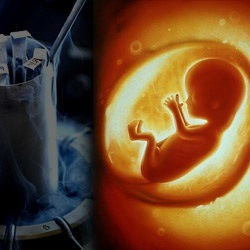From Choosing to Creating the “Better” Human
 Britain’s Human Fertilisation and Embryology Authority (HFEA), which oversees fertility treatments and embryo research in that nation, recently recommended that the creation of children with three genetic parents be allowed to move forward. Currently, it is illegal to transfer genetically modified embryos to a woman in Britain. The HFEA blessing will likely be used by lawmakers in the UK to change the law.
Britain’s Human Fertilisation and Embryology Authority (HFEA), which oversees fertility treatments and embryo research in that nation, recently recommended that the creation of children with three genetic parents be allowed to move forward. Currently, it is illegal to transfer genetically modified embryos to a woman in Britain. The HFEA blessing will likely be used by lawmakers in the UK to change the law.
For those who are not up to speed on the “three-parent” embryo technique, here is a quick primer. This variation of IVF was developed to “prevent” the inheritance of mitochondrial disease. Not all of our DNA that we inherit is in the nuclei of the egg and sperm that join at fertilization. In the cytoplasm of our mother’s egg are mitochondria. Mitochondria have their own DNA called mtDNA. We inherit our mtDNA only from our mother because sperm’s mitochondria are dumped at conception. There are genetic mutations that cause very serious disease found in mtDNA and a woman with a such a mutation cannot help but pass this mutation on to her children.
This technique, called maternal spindle transfer, removes the nucleus of an egg from a woman with mitochondrial disease and places it into a donor egg with normal mtDNA. That genetically modified egg is then fertilized with the father’s sperm and a genetically modified embryo is the result. An embryo with the genetic material from two women and one man.
Last week, while many Catholics were rightly focused on the Supreme Court arguements on same-sex marriage and all of the future implications, I was wringing my hands about this turn of events in the world of human genetic engineering for two very important reasons.
First, this technique will usher in a world where we are not just content to pick the “best” child out of many that the somewhat still natural process of IVF produces. It signals an acceptance of genetically engineering the next generation. Even though the fight against mitochondrial disease is a laudable endeavor, maternal spindle transfer and other techniques like it mean that medicine is pointed in the wrong direction: engineering children instead of treating disease.
Second, this is not your average gene therapy where one patient is treated in the cells affected by a faulty gene. This is a germ-line modification that will be passed on to every generation after. So not only does the HFEA approve genetic modifications to one child, but to grandchildren, great grandchildren, and great-great grandchildren. A dangerous precedent indeed, especially to those generations that never gave consent.
Marcy Darnovsky, from the progressive Center For Genetics And Society, said it succinctly, “People have characterized this as sliding down a slippery slope. This one actually throws us off a cliff.”
Do not think that this is simply a problem for the Brits. They at least have laws against techniques like maternal spindle transfer. Scientists in Oregon are poised to begin creating three-parent children with maternal spindle transfer. All that is needed here in the U.S. is approval from the Food and Drug Administration.
It may seem that the lack of reverence for the gift of human life could not be any greater than it is today. But I fear this signals a new, more devastating, culture of death. One that is not simply content to “choose a better human,” but one that now has to “create a better human.”

